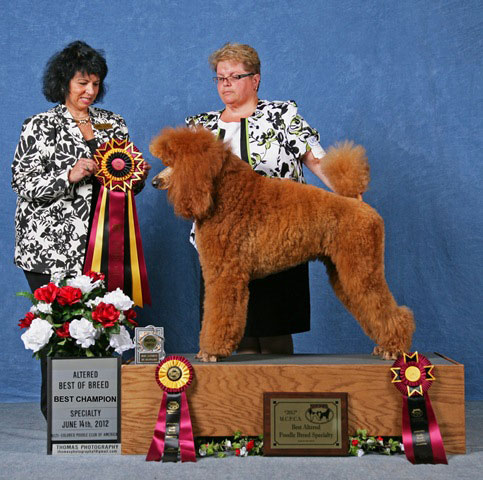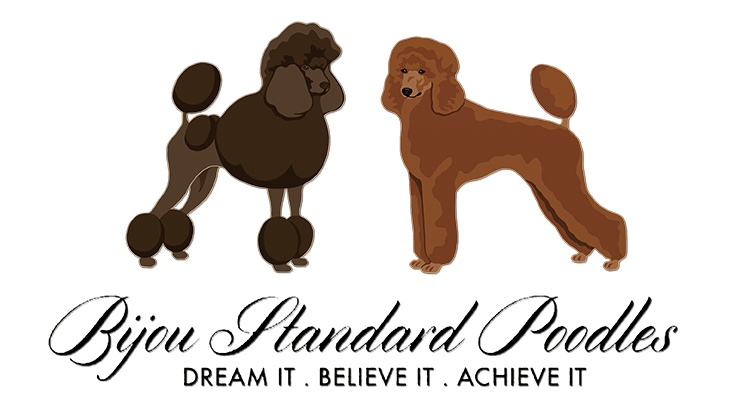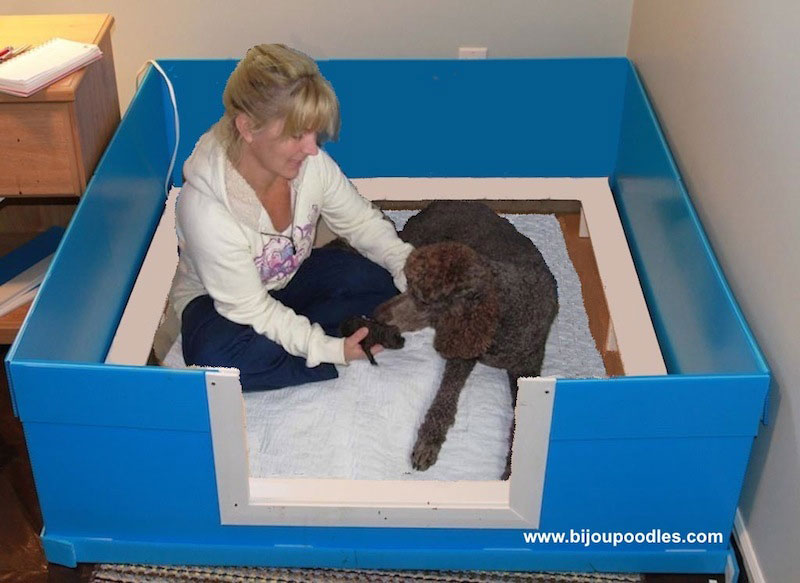
GOALS
Breeder's goals are not all the same.
Some breeders are breeding to perfect type or colour or temperament
or health or working ability. A Reputable Breeder will try to meet all of these qualities,
because perfecting all of these qualities would perfect their breed.
Some Breeders put two dogs together, for the long term goal
of using their progeny's progeny, that is how far in advance
and how much vision goes into some breeder's goals for their breeding program.
And then there are people that breed, that just put any two dogs together
for the quick dollar and nothing else.
Breeders have many different beliefs, practices and directions they will take
in order to best meet their breeding goals. As a result, not every breeder
will breed the same way. Challenges create choices and breeders should be
able to exercise their choices, as long as the mental and physical health
of their dogs and puppies are ensured above all else.
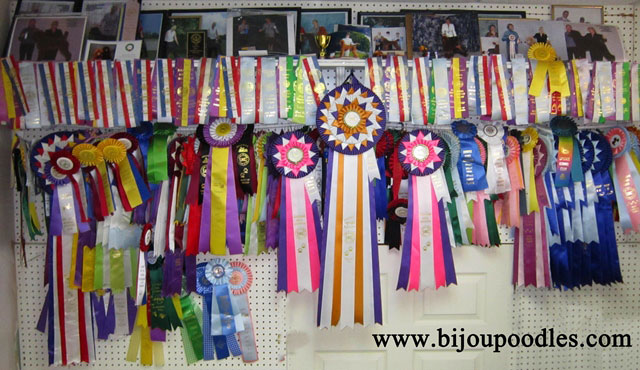
TITLES
Some Breeders feel that no dog should be bred until they achieve a title
in Conformation OR Working Events.
Some Breeders feel that no dog should be bred until they achieve
both a Conformation AND Working Titles
Having titles at both ends of the dog's name, means that dog is "balanced"
by proving without a doubt, that a dog is physically and mentally
a quality or superior specimen for their breed.
By breeding two such superior dog's together, a breeder should be constantly
improving and getting closer to the ideal, for their breed.
Some breeder's achieve nothing, with their dogs other than producing
puppies and they feel totally justified in selling the pups from unproven
untitled parents, for breeding purposes, to others.
These breeders feel that as long as their puppies are selling
than this is good enough for them.
It is up to the Puppy Buyer to decide which type of Breeder
they wish to support, by their choice of purchase.
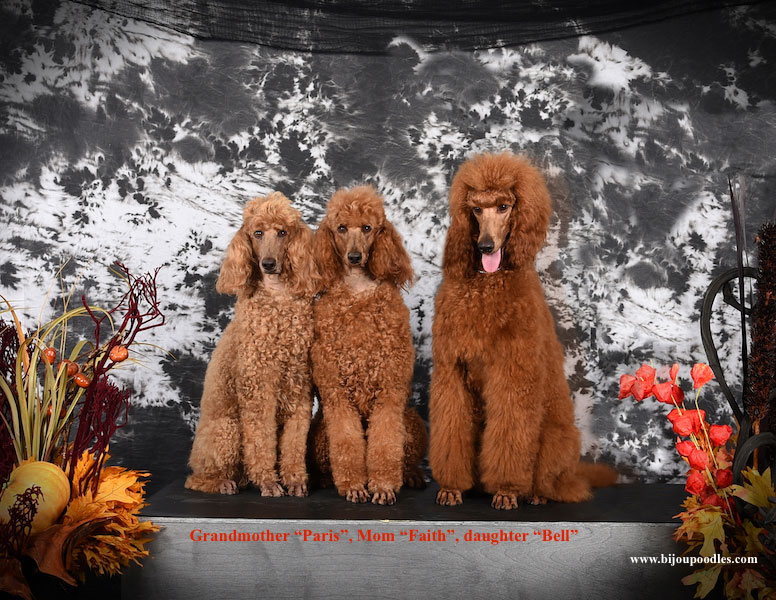
NUMBERS OF DOGS
Often "people" will site that how many dogs a Breeder owns will define a good or bad breeder. As of this writing, a breeder housing more than 20 intact females is considered a "Commercial Breeder". In reality no matter how many dogs a breeder owns, each and every dog should be well cared for and be mentally and physically in good condition which usually in itself, will self limit a breeder to a manageable number.
In order to breed for improvement, a breeder MUST have more than a couple females to breed and should be breeding with the intention of keeping pups for themselves, for their breeding program. As a result a breeder will have a few females, in order to be breeding scientifically and or, towards goals.
Some breeders are also working on different lines, or colours which will mean them owning more dogs than someone working on just one line or colour. Responsible breeders are breeding to better the breed and their lines, by keeping puppy(s) out of their breeding(s) to constantly improve on the next generation.
Often breeders will have older dogs that are done in contributing towards the Breeder's program. These dogs are often kept by the breeder even though they are not being used in a breeding program. A breeder breeding for a number of years also knows their limits. So often when they have a retired dog and no room they will want that cherished dog to enjoy the benefits of being in a home, where they can enjoy the "undivided" attention of a family and the new family benefits by not going through the trials and tribulations of puppyhood and also getting a well trained, beautiful, loving adult.
~ Retiring a loving friend to another home is not an easy choice for any Breeder ~
But being a responsible Breeder means always remembering what is best for their dogs at all times.
The number of dogs that a Reputable Breeder has or owns can constantly fluctuate,
as will the numbers of litters they produce because reputable Breeders are constantly
trying to achieve different goals towards improving their breeding lines.
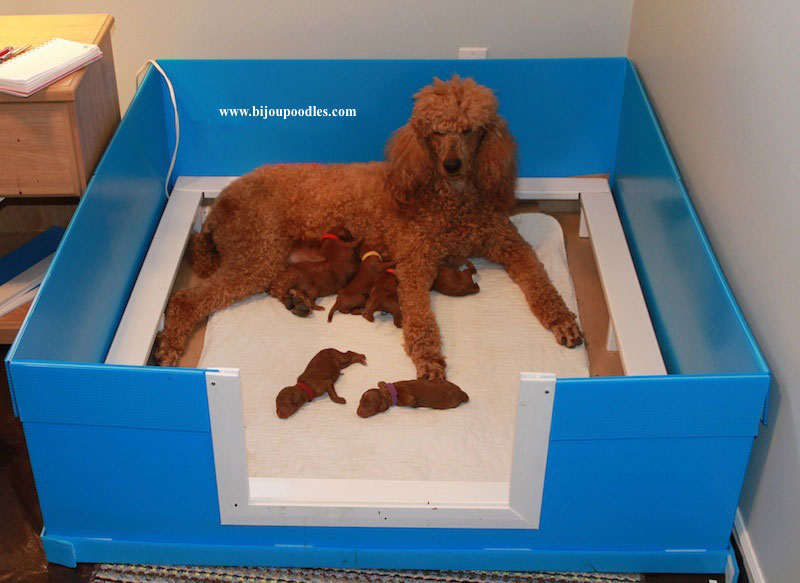
LITTERS PRODUCED
Often "people" will site that how many litters a year a breeder has, will indicate if a breeder is good or bad. In reality, all litters should be produced Responsibly no matter how many litters are produced. This means that ALL pups must be mentally and physically raised in good condition such as being properly dewormed, immunized, well socialized, friendly and outgoing, eager to meet new people clean and free of fleas, ticks and feces and have homes lined up for them prior to being produced, with the Pups the breeder is not keeping for breeding purposes spayed and or neutered before going home, or sold with enforceable non-breeding contracts.
A breeder will usually breed as many litters a year as the number of females that they own. This means a breeder owning 6 females will have 6 litters a year (if breeding every other heat) A breeder that owns 10 females will have 10 litters a year (if breeding every other heat) A breeder, producing 1 litter a year and not spaying or neutering and selling their pups with breeding rights can do more damage to the breed and contribute more to pet overpopulation, than a breeder breeding 10 litters a year Breeding Responsibly and spaying and neutering all the pups they produce.
Some breeders, are breeding scientifically, doing test breedings on their Poodles testing prepotency and this requires a female to be tested with various males and males tested with various females to prove these Poodle individuals are dominate contributors to a pedigree. Breeder's like this, contribute more to a breed by their exploration of genetics than a breeder breeding their females 1-3 times in their career. Of course some females are just so healthy and robust that they bounce back within a week or two of weaning and some females may never recover, so each female is different. There is no "cookie cutter" way to breed. AND you are not a "breeder" if you don't "Breed". I just love this article that sums it up Anti-Breeding, breeders
Numbers of litters should not be a sign of a good or bad breeder. Rather the goals in producing the litters, the care of mom and care and health of pups produced, the condition of the facility or home that the puppies are raised in, the condition of the pup's parents and the breeder's ability to have all the pups placed by 8 weeks, should be indicative of the quality of the Breeder in question. Which again will usually in itself, will self limit a breeder to a manageable number of litters that Breeders can properly raise and care for.
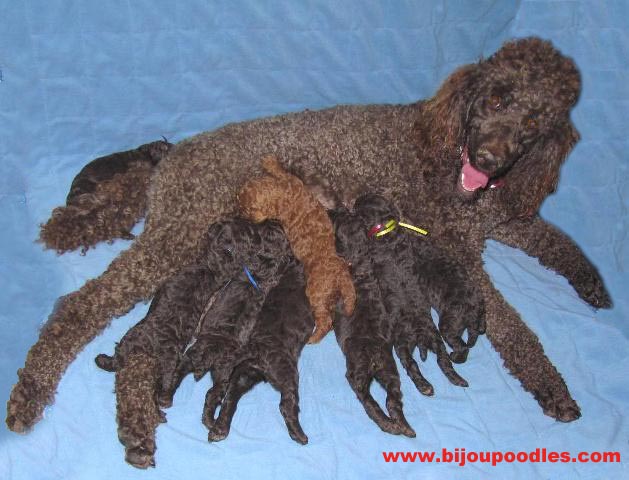
(A very happy mother "Sophie", smiling with her litter and a red foster puppy)
BREEDING FEMALES AT THE SAME TIME
Some new breeders and or pet people (non-breeders) feel it is bad practice to have 2 litters at the same time. Some experienced Breeders plan on breeding two females at the same time, this way if tne mother only has one puppy (some mom's constant attention will chill a puppy and not allow them to dry or get warm and to nurse) or has any problems (hormonal issues first time mom, milk not letting down or problem with the milk) that the other mother can foster puppy(s). Most females will cycle every 6 months. Some females however will cycle every 4 months. Females living together will also cycle at the same time, so breeding females at the same time will happen to every breeder eventually. The Breeder's experience, ability to properly care for, house, socialize and raise two or more litters at the same time, as well as have the pups all placed all before they are born and for sure before 8 weeks of age, should be indicative of a good or bad breeder.
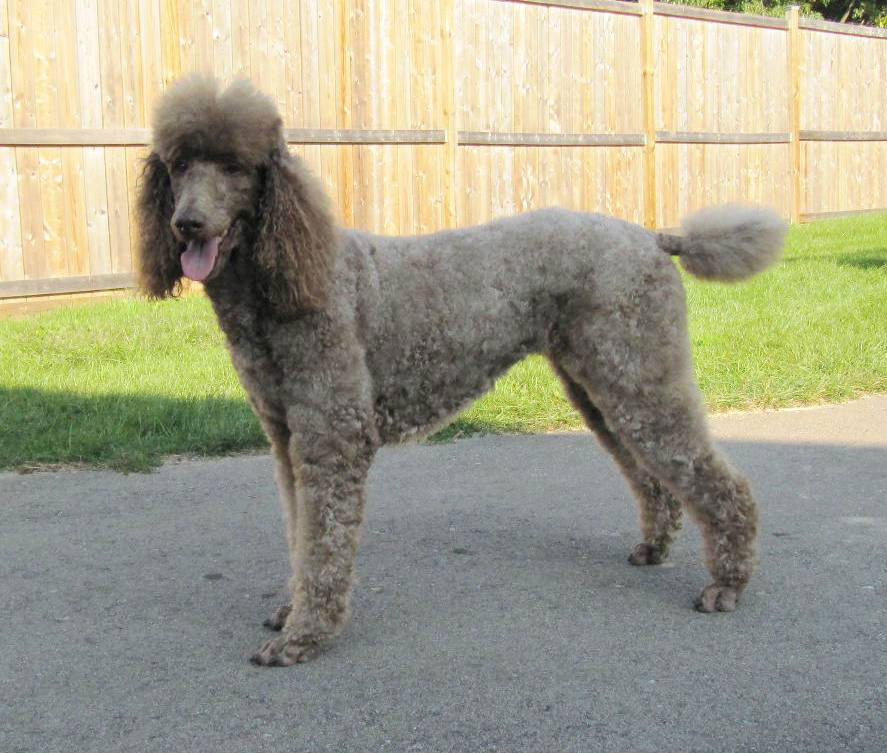
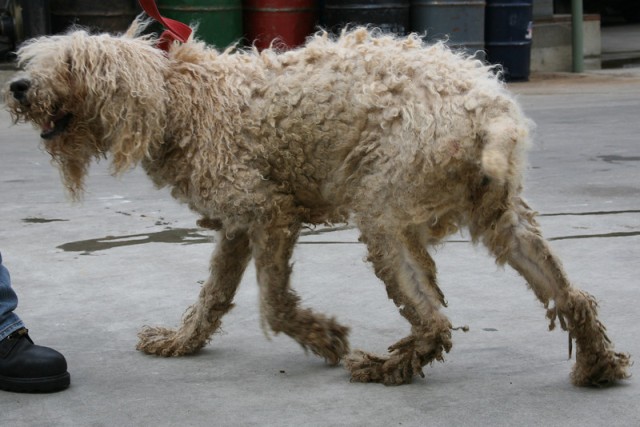
Bijou Female @10 years of age Florida Rescued Poodle Female @6yrs of age
who bred back to back on occasion, who bred 'every other' heat
during her "6 year" breeding career during her 6 year breeding career
BREEDING BACK TO BACK HEATS
Breeder's breeding every heat cycle (back to back) or breeding every other heat cycle should NOT be a sign of a good or bad breeder. Rather the goals in doing the Breeding, the Mental and Physical state of the mom (ie has she "tucked up" and is she in top physical state), the Breeder's ability to have loving homes lined up for all pups produced before the breeding happens, should be indicative of the quality of the Breeder in question. As we can see in the photos above, every female is different and not one practice is appropriate for every female. AND not every breeder has females in top physical condition.
~ In breeding there is no "cookie cutter" way to breed. ~
In 2010 at an AKC Dog Breeding Symposium held at Michigan State University It shocked many breeders when it was disclosed that there have been scientific studies to show that it is detrimental for bitches to skip heat cycles. It was shared that once you have begun to mate a bitch that you should NOT skip any heat cycles until she is completely finished breeding. A bitch is said to be "finished" breeding when her litter size is drastically decreased.
The study involved following females that were bred every heat cycle and females that were bred every other heat cycle. After they were "finished" breeding, the bitches were spayed and their uterus dissected. Those showing most stress, and damage of the uterus were the females that were bred "every other" heat cycle.
In the wild for dogs to be bred EVERY HEAT CYCLE it is what their bodies were meant to do. The Reproductive Experts explained that the skip every other heat program, was an myth probably started by people trying to impose their human emotions on to their dogs.
Part of the rational that skipping heat cycles is harmful, stems from the fact that with consecutive heat cycles there is no "flushing action" of the uterus, that normally occurs by having a litter of puppies. The female will go through Estrus, no matter if she is bred or not and by breeding a healthy bitch back to back, can lesson the chances of the female experiencing pyometra, infections and false pregnancies.
The choice to breed or not, should be contingent upon the goals the breeder has and for sure the mental and physical health of the female, above all else. The important information to take away from this study, is that a breeder with healthy females, does have "choices".
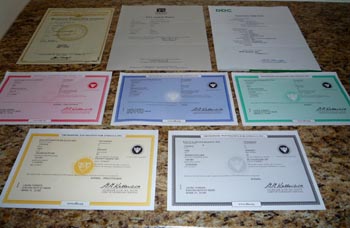 ...
...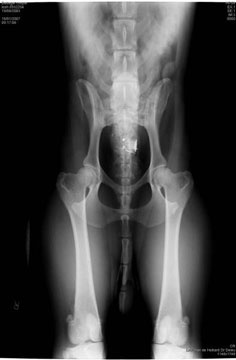
WHAT AGE TO BREED
Some people will say that "you should not breed a female before 2 years of age".
However many experienced Breeders, will bred healthy females
at 1 year of age or a female's second heat.
Many "experienced" Breeders believe that breeding when the female is mature
will avoid Pyometra and fertility problems that can happen when the female
goes through too many heat cycles and is not spayed, or not bred.
AKC registers litters from: Females 8 months of age until 12 years of age
AKC registers litters from: Males 7 months of age until 12 years of age
AKC considers these ages "acceptable practice".
"Physically" a female should not be bred before she is physically mature.
Determining when physical maturity depends on when a female comes into heat or estrus.
The magic age of "2" years of age came about when Xraying
and grading hips through OFA began
in an attempt to eliminate or reduce the chances of Hip Dysplasia
being passed on to puppies from affected parents.
In order to have a dog's hips evaluated and certified
a dog must be 2 years of age on the day the Xray is taken.
This is the ONLY reason that 2 years of age became
common practice and no other reason
Some females are mentally and physically ready to have pups at 1 year of age
and some others not until they are 3 years or more.
Every female is different and it is up to all breeders
to know their dogs and do what is best for them.
A lot of breeders experiencing problems with conception or infections
because of letting their females go through too many heats without being bred
discovered that OFA Preliminary Evaluation
can be done at 4 months of age had 97.9% reliability. As well breeders also began using another tool called PennHip
(Pennsylvania Hip Improvement Program) which is an evaluation also done at 4 months of age.
Some breeders also feel totally comfortable in breeding their females "before" OFA certification
"if" they were out of OFA'd parents, and all DNA health testing is completed
knowing that producing a litter has minimal effect her structurally.
The Orthopaedic Foundation for Animals (OFA) recommends radiographing
three to four weeks before or after the heat cycle, and three to four weeks after weaning a litter of puppies.
With out a doubt ALL breeders should be doing every available conclusive health test on ALL their breeding dogs.
In Standard Poodles this means:
OFA Hip, Elbows, Patella Luxation, Legg-Calve-Perthes, Thyroid Disease,
Congenital Cardiac Disease, Von Willebrand's Disease, Degenerative Myelopathy, Dentition,
Neonatal Encephalopathy with Seizures Disorder and even inconclusive test of CERF
(Canine Eye Registration Foundation ) every 2 years.
Basically Breeders do have
~ OPTIONS ~ of breeding healthy female when they are physically and mentally mature ~

How many times to breed a female during her heat cycle is an age old debate.
"Ideally" it is accepted practice to breed 10th, 12th day and 14th day and only ever, once a day.
However a lot of Breeders found that their females were "missing" or had small litters,
even after using a different proven male. This is usually because breeder's ignore their female.
A female will tell you when she is ready to be bred, by her flagging when her vulva is touched.
There is no point in ignoring this sign just because it is the 8 or 9th or 16th day
according to your records, as you may have missed the early signs of heat.
Some breeders even panic and decide to AI rather than miss another breeding opportunity.
Of course a lot of AI's are done incorrectly, introducing foreign materials into the sterile environment of the bladder,
causing infection and no pregnancy. This resulting "infection" can have a breeder "incorrectly" thinking
this is the reason a female missed. When doing an AI use an experienced "Breeder".
Some breeders are afraid that breeding beyond the usual dates could result in pups being not fully developed.
While this is a real possibility, the chances are MINIMAL and the opportunity for a successful litter,
is generally worth the risk.
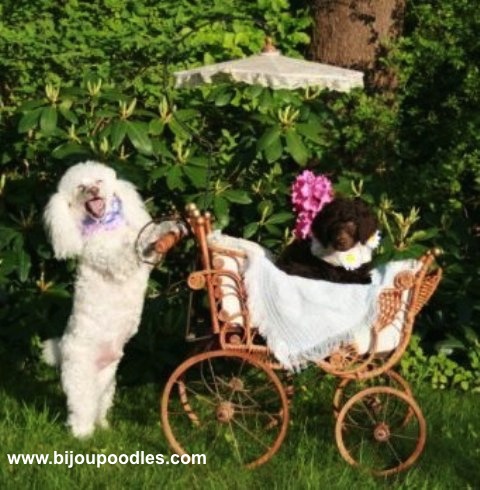
WHEN TO RETIRE BREEDING DOGS
What age should you stop breeding your female, is another debate
often had between Novice Breeders or non-breeders and Experienced Breeders.
AKC registers litters from: Females 8 months of age until 12 years of age
AKC registers litters from: Males 7 months of age until 12 years of age
AKC considers these ages "acceptable practice".
Canine Reproductive specialists will say that a healthy female can be bred until the number of pups in her litters
is drastically decreased. Some breeders spay their females after a certain number of litters have been produced
or until they have reached their breeding goals with that female. Some other breeders have bred their females until a certain age.
Experienced breeders have bred HEALTHY females at 8+ years of age.
The choice to breed or not, should be contingent
upon the goals the breeder has and for sure the mental and physical health of the female, above all else.
So really a Breeder has "choices" of what age they will breed their female(s) until.
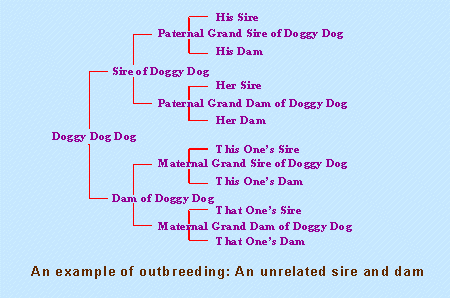
INBREEDING, LINEBREEDING, OUTCROSS BREEDING
Inbreding, line breeding or outcross breeding choices.
In the 2000s online pedigrees and COI programs became readily available to the public.
COI stands for Coefficient Of Inbreeding and is the calculation used to determine the level of inbreeding
on an individual dog or puppy. The higher the number for COI the closer the dog or puppy was inbred.
Public access to this information was met with great enthusiasm, with some Breeders deciding
to avoid all Line and inbreeding, equating a litter with a high COI as being an undesirable breeding.
Some breeders decided that knowing the COI on each of your proposed breeding was a valuable tool
to consider but that it would not be the deciding factor in doing or not doing a breeding.
Some breeders decided that they would construct a breeding, using the COI to find out if the breeding
would be close enough on a common ancestor of merit, to enhance their breeding program,
knowing that a higher COI on healthy lines could really bring forth desirable qualities.
Online pedigrees and COI programs are a wonderful tool available to breeders, enabling them to make
educated choices for their breeding program, however how well the knowledge is used,
is limited upon the Breeders knowledge and experience.
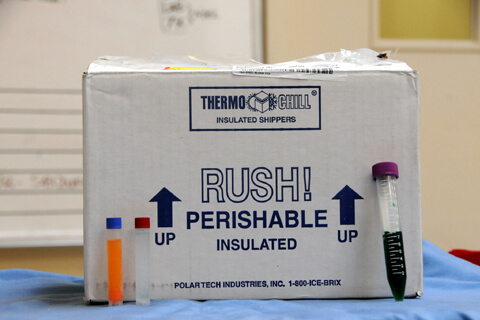
IMPORTING DOGS or SEMEN
Importing dogs or sperm, for the breeding program.
The world is a small place thanks to the Internet.
Breeders are no longer limited to using dogs or lines
that they can see in the flesh or that is within driving distance.
Novice Breeders and Non-Breeders, are often easily impressed by the ability to purchase a dog from "overseas".
They feel an imported dog or sperm from a foreign Stud, will impress others and Puppy Buyers.
Experienced Breeders know that "many" European Breeders don't do any of the common OFA Health Testing
and do not use any European dogs, feeling that they could introduce variety of inherited health problems.
Breeders buying foreign dogs are taking a chance that those dogs will pass all health testing and be issue free.
Some European breeders do not maintain the same vaccination protocol that we do in North America
and as a result pups produced may not have expected immunity to common ailments that North American
puppies will have. Adults may even die of canine distemper, parvovirus or an upper respiratory infection
such as distemper associated pneumonia as a result. Before you import a puppy or buy from imported parents,
ask if the parents are still alive and healthy, as you do not want to import a Poodle with immunodeficiency.
Some breeders felt that the physical appearance of the European stock
is too different to what is currently acceptable in North America as "desirable"
towards the breed standard, to consider using in their breeding program.
Many Poodles imported from Europe suffer from structural defects
because they are are being bred for exaggeration of breed type,
to the point that Poodles are Sickle and weak hocked, straight shouldered
flat or paper footed and are very overangulated
with poor movement of overreaching, with many having weak ligaments and or walking on their hocks.
Many breeders find that the paper work provided is also not recognized by AKC and then will end up
with a Poodle that they are unable to show or breed, because they can not get AKC registration for them.
Or discover that their "imported" Poodles go back to common North American Lines they could get at home.
Yet other breeders have decided the smaller more refined European stock
would help them breed towards a smaller dog.
(In Standard Poodles for instance, Moyen or Klein size in 2011 is the latest and greatest trend).
Importing dogs or importing sperm from around the world is an incredible opportunity
for breeders to obtain different looks, lines connections;
but how much an import will enhance a breeder's program, is contingent upon the dog's qualities,
both Genotype AND Phenotype and of course Health, Breeder's knowledge of the
Poodle Breed Standard
and not the country, that the dog was obtained from.
For Example...
(Common offenders do not copy this information, find your own references, I'm tired of making you look like you have a brain)This one breeder bred her females at only a year of age.
Bred her males BEFORE they were a year of age.
Did NO health testing.....
Bred son to mother and daughter to father and did some tight line and in-breedings back on that.
COI's were well over 40% or like "AM/CAN CH Wycliffe Michael" whose 10 generation COI of 93.32%
She also bred her females back to back on their heats.
Bred a number of litters a year
If you ever want to read about this "BREEDER" look up the World famous Wycliffe Poodles, breeder, Jean Lyle
who had the greatest positive (some would say negative) impact, on our breed to date, with her scientific "Breeding Practices".
~ GOALS, ARE WHY REPUTABLE BREEDERS, BREED ~
Goals are why all Reputable Breeders breed and how each Breeder attempts to get to those goals will differ greatly.I am sure most of us have had moments in our life where we have felt self righteous,
usually when we first start out breeding and were very naive, before we found experienced Breeders to use as mentors.
We have looked at what someone else is doing with their breeding practices and thought
"wow how awful they are doing that"
New Breeders learn pretty fast that they do not know everything.
They can't possibly know what others are trying to accomplish in their breeding goals unless they ask, not judge.
New Breeders usually learn as they make their own mistakes and mentally mature in the process
usually eating a good helping of "humble pie" along the way.
New and experienced Breeders should keep their minds open to learning opportunities,
from where ever they come from, including breeders of other breeds, breeders of other species,
but especially learning from those Breeders who have been, or are successful, in their breeding programs.
Bottom line is that a Breeder can not be open to learning, advancement or growth,
if they are too busy being critical of those around them.
Breeder's also have to consider that "just because you can, doesn't mean you should".
Breeders should use common sense and consider the short and long term consequences for all their actions.
~ A Breeders Life ~
A Breeder (with a capital B) is one who thirsts for knowledge and never really knows it all,one who wrestles with decisions of conscience, convenience, and commitment.
One that shares this knowledge and guides those interested.
A Breeder is one who sacrifices personal interests, finances, time, friendships, fancy furniture
and time with family on holidays, because of a dog in labor.
The Breeder goes without sleep in hours spent planning a breeding or watching anxiously
over the birth process and afterwards, over every little wiggle or cry.
The Breeder skips dinner parties because the litter is due or the babies have to be fed at 8.
The Breeder disregards birth fluids and puts mouth to mouth to save a gasping newborn
literally blowing life into a tiny helpless creature that may be someone's dream.
A Breeder's lap is a marvelous place where dogs often sit and her face to receive endless kisses.
A Breeder's hands are strong and firm and often soiled, but ever so gentle and kind.
A Breeder's back and knees are usually arthritic from bending over and sitting in the whelping box,
but are strong enough to guide that newborn little pup to maturity.
A Breeder's shoulders are often heaped with responsibility,
but they're wide enough to support the weight of a thousand defeats and frustrations.
A Breeder's arms are always able to wield a mop, support an armful of puppies,
or lend a helping hand to a new comer.
A Breeder's ears are wondrous things, sometimes red (from being talked about),
or strangely shaped from being pressed against a phone receiver, often deaf to criticism,
yet always fine tuned to the whimper of an anxious puppy.
A Breeder's brain is foggy on faces, but can recall pedigrees faster than the fastest computer.
A Breeder's heart is often broken, but it beats strongly with hope everlasting...and it's always in the right place.
Oh, yes, there are breeders, and then, there are BREEDERS!!!
~ Author Unknown ~
